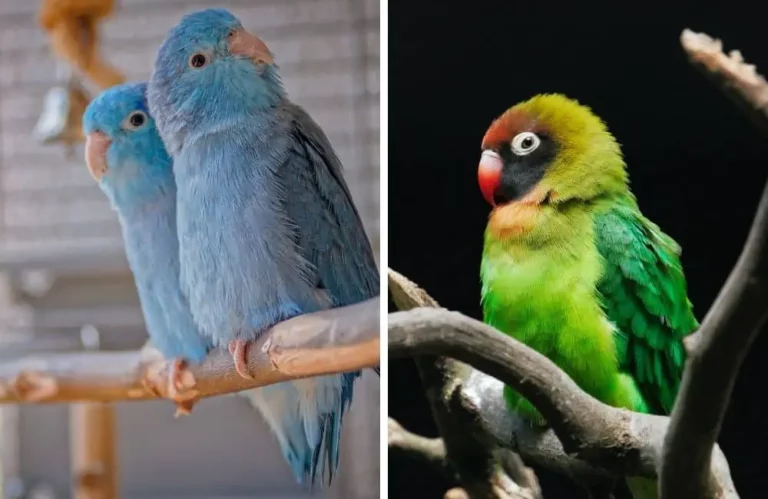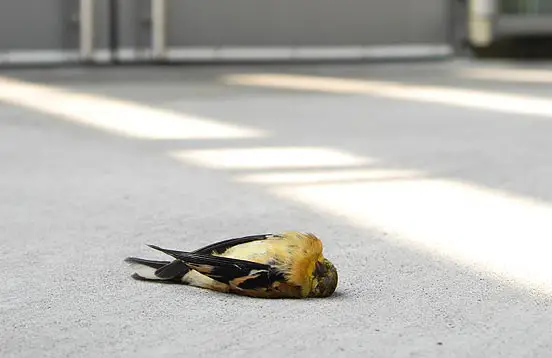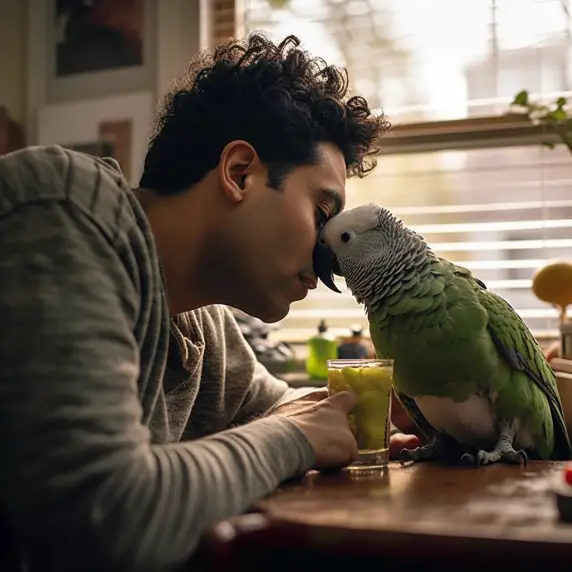Positive Reinforcement in Bird Training: Principles & Best Practices
Training your bird is essential for their mental stimulation, overall well-being, and the development of a strong bond between you and your feathery friend. One of the most effective and humane methods to achieve this is through positive reinforcement training.
This approach focuses on rewarding good behavior rather than punishing undesired actions, making the learning experience enjoyable for both you and your bird.
Birds, especially parrots, are highly intelligent creatures that require mental stimulation to thrive. Training not only provides this much-needed stimulation but also strengthens the trust and bond between you and your bird.
When a bird is trained using positive reinforcement, it becomes more confident and less prone to stress and anxiety.
Positive reinforcement training offers numerous benefits. It promotes a healthy and loving relationship between you and your bird, reduces stress, improves behavioral issues, and helps develop a well-mannered, happy, and sociable pet.
By choosing this method, you set the stage for a lifetime of learning and companionship with your feathered companion.
Understanding Positive Reinforcement
Definition of positive reinforcement
Positive reinforcement is a powerful technique in behavior modification that involves rewarding desired behaviors to increase their occurrence over time. In bird training, positive reinforcement involves offering your bird a treat, praise, or other rewards when it performs a desired action or behavior.
This reward acts as a motivator, encouraging your bird to repeat the behavior in the future.
Types of reinforcers
1. Primary reinforcers
Primary reinforcers are natural rewards that satisfy a bird’s basic needs, such as food or water. In training, using treats like seeds, fruits, or nuts can be highly effective as primary reinforcers.
However, it’s crucial to choose healthy options and ensure that the treats do not exceed more than 10% of your bird’s daily diet to maintain their overall health.
2. Secondary reinforcers
Secondary reinforcers are learned or conditioned reinforcers that become rewarding through association with primary reinforcers. In bird training, clickers or verbal cues, such as praise, can serve as secondary reinforcers.
These reinforcers can be especially helpful when combined with primary reinforcers, as they help create a clear association between the desired behavior and the reward.
The role of timing and consistency in reinforcement
Timing and consistency play crucial roles in the success of positive reinforcement training. When rewarding your bird, it’s essential to deliver the reward immediately after they perform the desired behavior.
This immediate reinforcement helps the bird associate the action with the reward, increasing the likelihood of repeating the behavior in the future.
Consistency is equally important in training. Maintaining a consistent approach, such as using the same cues, rewards, and timing, ensures that your bird understands the connection between their actions and the positive consequences that follow.
Being consistent will help your bird learn new behaviors and commands more effectively and quickly.
Getting Started with Bird Training
1. Selecting the right environment
Choosing the right environment for training is critical to ensure your bird feels comfortable and is not easily distracted. Find a quiet and calm space in your home, free from loud noises or disturbances. It is also essential to ensure that the area is safe and secure, with no hazards or potential escape routes for your bird.
2. Choosing the right training time
Birds are most receptive to learning when they are alert, well-rested, and not overly hungry. Identify the best time for your bird based on its natural daily rhythms and routines. Typically, morning or early evening sessions work well. Limit the training sessions to 10-15 minutes, as longer sessions may lead to boredom or fatigue.
Consistency is key, so try to maintain regular training sessions throughout the week.
3. Gaining your bird’s trust
Trust is the foundation of successful bird training. Spend time interacting with your bird outside of training sessions to develop a strong bond. Offer treats, talk gently, and engage in mutual preening to foster trust and establish yourself as a source of comfort and safety.
4. Identifying your bird’s favorite treats and rewards
Understanding your bird’s preferences is crucial to ensure the rewards used during training are motivating enough. Observe your bird closely and take note of their favorite treats, toys, or activities. These preferences may change over time, so it’s essential to stay attuned to your bird’s likes and dislikes.
Also, consider reserving certain treats exclusively for training sessions to enhance their value as a reward.
Training Techniques Using Positive Reinforcement
Target training
Target training is a foundational technique that involves teaching your bird to touch a designated object, such as a stick, with its beak. This method can be used to guide your bird towards a specific location or to perform more advanced tricks.
Start by presenting the target object and rewarding your bird immediately when they touch it. Gradually increase the distance or complexity of the task while consistently rewarding your bird for each successful attempt.
Clicker training
Clicker training is a powerful tool that utilizes a small device that produces a distinct clicking sound to signal that a desired behavior has been performed. Begin by pairing the clicker with a primary reinforcer, such as a treat, to create a positive association.
Once the bird understands that the click means a reward is coming, use the clicker to mark the precise moment your bird performs the desired behavior, followed by providing the reward. The clicker serves as a clear, consistent communication tool, helping your bird understand which actions lead to rewards.
Shaping behavior
Shaping is a technique that involves gradually building a complex behavior by rewarding smaller steps towards the desired action. Start by rewarding your bird for any movement or action that resembles the final goal.
Then, incrementally increase the criteria for the reward, only reinforcing behaviors that are closer to the desired outcome. Shaping allows your bird to learn at its own pace, building on existing skills and increasing the complexity of behaviors over time.
Capturing and reinforcing spontaneous behaviors
Capturing involves recognizing and reinforcing desirable behaviors that your bird performs spontaneously. When you notice your bird exhibiting a desired action, immediately reward them with a treat or praise.
This technique allows you to teach your bird new tricks or commands based on their natural instincts and abilities, making the learning process more enjoyable and organic.
Essential Commands and Tricks to Teach Your Bird
Step-up command
Teaching your bird the step-up command is crucial for safe handling and building trust. To teach this command, gently present your finger or a handheld perch near your bird’s feet while giving a verbal cue such as “step up.”
As soon as your bird steps onto your finger or the perch, reward them with a treat and praise. Repeat this exercise consistently until your bird responds reliably to the command.
Recall training (flying to you on command)
Recall training teaches your bird to fly to you when called, enhancing your bond and ensuring their safety. Begin by standing a short distance away from your bird and calling their name or using a specific cue while offering a treat. As your bird flies to you, reward them with the treat and praise.
Gradually increase the distance between you and your bird during training sessions, always providing positive reinforcement upon successful completion of the task.
Turning around
Teaching your bird to turn around on command is an entertaining trick that also helps improve their coordination and balance. Using a target stick or your finger, guide your bird to follow the target in a circular motion until they complete a full rotation.
Immediately reward them with a treat and praise. Practice this trick consistently until your bird can perform the action without guidance.
Waving or shaking their head
Training your bird to wave or shake their head can be a fun way to engage with them and showcase their intelligence. Hold a treat near your bird’s beak and slowly move it from side to side, encouraging them to follow the treat with their head. Once your bird begins to move their head, give them the treat and praise.
Over time, gradually phase out the treat’s guidance and use a verbal cue to prompt the desired action.
Fetching objects
Teaching your bird to fetch items is an interactive and mentally stimulating exercise. Begin by offering your bird a small, lightweight object and rewarding them when they take it with their beak. Then, gradually introduce the concept of retrieving the object by placing it slightly farther away each time.
When your bird picks up the object, encourage them to bring it back to you, rewarding them with a treat and praise for their success.
Mimicking sounds and talking
Many bird species, particularly parrots, are capable of mimicking sounds and even talking. To teach your bird to mimic sounds or words, consistently repeat the desired sound or word in a clear and enthusiastic tone during training sessions.
When your bird attempts to mimic the sound, reward them with a treat and praise. It’s important to be patient, as this skill can take time for your bird to master.
Addressing Behavioral Issues with Positive Reinforcement
Identifying the root cause of problem behaviors
Understanding the underlying reasons for your bird’s problem behaviors is crucial in effectively addressing them. Common causes include boredom, stress, fear, or medical issues.
By identifying the root cause, you can create a targeted training plan that uses positive reinforcement to encourage healthier and more desirable actions.
Redirecting unwanted behaviors
Redirecting undesired behaviors involves offering your bird an alternative, acceptable behavior to replace the problematic one. For example, if your bird is screaming for attention, redirect them to a more appropriate activity, such as foraging or playing with toys.
When your bird engages in the alternative behavior, reward them with treats and praise to reinforce the positive action.
Using positive reinforcement to promote desired behaviors
Instead of punishing your bird for unwanted behaviors, focus on reinforcing desirable actions using positive reinforcement. This approach helps create a strong association between the preferred behavior and the reward, making it more likely that your bird will choose the desired action over the undesired one.
Consistency and patience are essential in successfully addressing behavioral issues.
The importance of patience and persistence
Addressing behavioral issues using positive reinforcement can take time, and progress may be gradual. It’s essential to remain patient and persistent in your training efforts, adjusting your approach as needed.
In some cases, seeking assistance from an experienced bird trainer or avian behaviorist may be necessary to address more complex or persistent issues effectively.
Maintaining Progress and Continuing Education
Varying rewards and reinforcement schedules
As your bird becomes more proficient in their training, consider varying the rewards and reinforcement schedules to maintain their interest and motivation. Mixing different types of treats, praise, or playtime can keep your bird engaged in the learning process.
Additionally, implementing an intermittent reinforcement schedule, where rewards are given less frequently or unpredictably, can encourage your bird to maintain their learned behaviors even when not rewarded every time.
Introducing new challenges and tricks
To ensure continued mental stimulation and growth, introduce new challenges and tricks to your bird’s training repertoire. This will not only keep them engaged and interested but also help maintain and improve their cognitive abilities.
Introducing new tasks and behaviors should be done gradually, ensuring that your bird is comfortable and confident with their existing skills before moving on to more advanced ones.
Monitoring your bird’s emotional well-being
During the training process, it’s essential to monitor your bird’s emotional well-being to ensure they are not becoming stressed or overwhelmed. Watch for signs of distress, such as feather plucking, pacing, or excessive vocalizations.
If you notice any of these signs, consider adjusting your training approach, providing more downtime, or seeking guidance from a professional bird trainer or avian behaviorist.
The role of socialization in training success
Socialization plays a crucial role in your bird’s overall happiness, confidence, and ability to learn new behaviors. Encourage socialization by gradually introducing your bird to new people, animals, and environments.
Ensuring that your bird is well-socialized not only enhances their overall well-being but also makes training more effective by creating a more adaptable and receptive learner.
Frequently Asked Questions
How long does it take to train a bird using positive reinforcement?
The duration of training depends on various factors, such as the bird’s age, personality, and previous experiences. Consistent training sessions and patience are crucial to see progress over time.
Can I train an older bird using positive reinforcement?
Yes, older birds can still learn through positive reinforcement, but it may take longer than with younger birds. It’s essential to be patient and adapt your training approach to your bird’s abilities and preferences.
Is it possible to train multiple birds at once with positive reinforcement?
Training multiple birds at once can be challenging, but it’s possible. It’s essential to manage the environment, use individualized reinforcers, and provide each bird with personal attention during training sessions.
What should I do if my bird isn’t responding to positive reinforcement?
Ensure that the reinforcer you are using is motivating enough, maintain consistency in your training, and consider adjusting your training approach. Seeking advice from an experienced bird trainer or avian behaviorist can be helpful.
Can positive reinforcement help with aggressive behaviors in birds?
Yes, positive reinforcement can help manage aggression by identifying the triggers and reinforcing calm and relaxed behaviors. It’s essential to be patient, consistent, and work closely with an avian behaviorist to address aggression effectively.
Key Takeaways and Tips for Success
Using positive reinforcement in bird training promotes a stronger bond between you and your bird, reduces stress, and creates an enjoyable learning experience. This method focuses on rewarding desired behaviors, making it more likely that your bird will continue to perform these actions in the future.
Being consistent with your training approach, providing rewards immediately following the desired behavior, and maintaining patience are all crucial factors in the success of positive reinforcement training.
Consistency and timing ensure your bird understands the connection between their actions and the positive consequences, while patience allows them to learn at their own pace.
Take the time to understand your bird’s individual needs and preferences, from their favorite treats to their optimal training times. Catering your training approach to your bird’s specific requirements will help create a more engaging and effective learning experience.
Training should be an ongoing process, with new challenges and tricks introduced over time to maintain mental stimulation and growth. Monitoring your bird’s emotional well-being and socialization throughout the training process is essential to ensure their happiness and overall health.
If you encounter challenges in your bird training journey or notice signs of distress in your bird, do not hesitate to seek advice from experienced bird trainers or avian behaviorists. These professionals can provide valuable guidance and support to ensure the success of your bird’s training and overall well-being.






